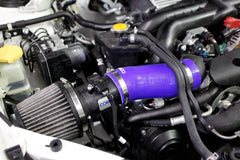Your Cart is Empty
 An aftermarket air intake system used to be an easy way for owners of turbocharged cars to add gobs of power. Technology marches on, though, and the newest factory-built intakes are much better. Horsepower gains from intake systems on the WRX are smaller than they used to be, but there still are a few horsepower (maybe five) to be gained, and as other modifications increase, the added power will go up as well.
An aftermarket air intake system used to be an easy way for owners of turbocharged cars to add gobs of power. Technology marches on, though, and the newest factory-built intakes are much better. Horsepower gains from intake systems on the WRX are smaller than they used to be, but there still are a few horsepower (maybe five) to be gained, and as other modifications increase, the added power will go up as well.
The Cobb Tuning SF intake pictured here is one of our most popular systems.
At this point we have to address some myths and misconceptions about intake systems on the Subaru related to air/fuel metering. First of all, on all Subaru turbo engines, fuel metering is managed by use of a Mass Air Flow meter, or MAF for short. This air flow sensor lives in the intake system, just after the factory air filter in the airbox. Aftermarket intake systems aim to increase air flow and cut down on resistance to incoming air by providing a simpler and/or smoother path for the air to pass through. But the aftermarket intake also replaces the tube through which the MAF senses air flow. ANY changes to the layout of this air passage way -- bends, small changes in diameter, even presence or lack of fins upstream of the sensor -- can change the voltage the sensor reads at a given airflow level. That would mean the ECU could misunderstand the amount of air entering the engine, and in the worst case, the air/fuel mixture could become dangerously lean.
Perhaps because of this, many people think that all intakes for the Subaru will result in instant engine destruction. That's not true -- some intakes leave the operation of the MAF just like stock, so in that case the intake would have no adverse effect on fueling. But we have witnessed some intake designs that were so far off from the factory calibration that they COULD permanently harm the engine if used without corresponding ECU adjustments. This is especially true for 2008+ cars, which seem to be even more sensitive to changes in the MAF metering compared to older cars.
Proper ECU calibration can account for almost any difference in intake size, design, or calibration, so if you have an ECU map that is specifically designed for a particular intake system, you are all set.
For this reason we highly recommend choosing your intake systems carefully, and we definitely suggest installing an ECU calibration that is specifically designed for the intake system you have selected. We've tested all the intake systems we sell, and for the most part they have a minor, if any, effect on air/fuel metering. We STILL suggest that you install a pre-made or custom-made ECU map after installing ANY of these intake systems, to be sure the ECU is precisely calibrated for the intake system. Currently there are pre-made Cobb Accessport maps available for the Cobb SF intake for all high-performance models. You can run other brand intake systems, but you MUST have a custom ECU map made for the intake system you choose.
Next: Cat-Back Exhaust Systems